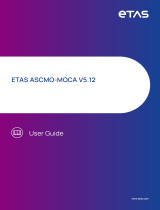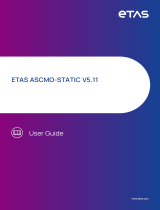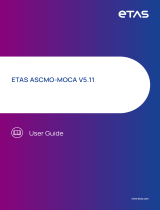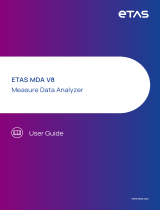Page is loading ...

ETAS ASCMO-DYNAMIC V5.12
User Guide

Copyright
The data in this document may not be altered or amended without special noti-
fication from ETAS GmbH. ETAS GmbH undertakes no further obligation in relation
to this document. The software described in it can only be used if the customer is
in possession of a general license agreement or single license. Using and copying
is only allowed in concurrence with the specifications stipulated in the contract.
Under no circumstances may any part of this document be copied, reproduced,
transmitted, stored in a retrieval system or translated into another language
without the express written permission of ETAS GmbH.
© Copyright 2023 ETAS GmbH, Stuttgart
The names and designations used in this document are trademarks or brands
belonging to the respective owners.
MATLAB and Simulink are registered trademarks of The MathWorks, Inc. See math-
works.com/trademarks for a list of additional trademarks.
ASCMO-DYNAMIC V5.12 | User Guide R01 EN | 10.2023

Contents
1 Safety and Privacy Information 6
1.1 Demands on Technical State of the Product 6
1.2 Intended Use 6
1.3 Target Group 6
1.4 Classification of Safety Messages 6
1.5 Safety Information 7
1.6 Privacy Notice 8
1.6.1 Data Processing 8
1.6.2 Technical and Organizational Measures 8
2 About ETAS ASCMO 9
2.1 ETAS ASCMO –Overview 9
2.2 Finding Out More 9
3 Installation 10
3.1 Preparation 10
3.1.1 User Privileges 10
3.1.2 Additional Software Requirements 10
3.2 Installing 10
3.2.1 Start Menu 13
3.2.2 Files and Directories 14
3.2.3 P-Code Version 14
3.3 Licensing 15
3.4 Uninstalling 16
4 Basics of ASCMO-DYNAMIC –Overview 17
4.1 Fields of Application 17
4.2 Model-Based Calibration 18
4.3 Nonlinear Autoregression With Exogenous Inputs (NARX) 19
4.4 Recurrent Neural Networks (RNN) 20
5 Working with ASCMO-DYNAMIC 21
5.1 User Interface of ASCMO-DYNAMIC 21
5.2 Elements of the ASCMO-DYNAMIC User Interface 21
6 Tutorial: Working with ASCMO-DYNAMIC 25
6.1 Inputs and Outputs of the Measured Engine 25
ASCMO-DYNAMIC V5.12 | User Guide
Contents | 3

6.2 Data Import 26
6.3 Data Analysis 29
6.3.1 Training Data Table 29
6.3.2 Scatter Plots 30
6.3.3 Resampling 32
6.3.4 Noise Filtering 33
6.3.5 Cross Correlation Inputs 33
6.3.6 Amplitude Spectra 34
6.3.7 Phase Plot, ACF and IACF 35
6.4 Model Training 37
6.4.1 Modeling Method and Algorithm 40
6.4.2 Feedback Structure (NARX) 42
6.4.3 Dimensionality Reduction 42
6.5 Model Prediction 46
6.5.1 Sigma Prediction 46
6.5.2 Multi-Step/One-Step Ahead Prediction 47
6.6 Model Validation 47
6.6.1 Model Validation with Scatter Plot 48
6.6.2 Measured vs. Predicted 49
6.6.3 Cross Validation 49
6.6.4 Cross-Correlation of the Residuals (CCR) Validation 50
6.7 Model Export 52
6.7.1 Export to MATLAB® 52
6.7.2 Export to Simulink® Model 53
6.7.3 Export to INCA/MDA 54
6.7.4 Export to C Code 55
6.7.5 Export to GT-Suite 56
6.7.6 Export to FMI 56
7 Tutorial: Working With ASCMO-DYNAMIC ExpeDes 58
7.1 Starting ASCMO-DYNAMIC ExpeDes 59
7.2 Step 1: General Settings 61
7.2.1 Input Configuration 61
7.2.2 Measurement Size Configuration 63
7.3 Visualizing the Dynamic Experimental Plan 63
7.4 Step 2: Constraints 66
7.4.1 Constraint Types "Map" and "Curve" 68
7.4.2 Managing Curves and Maps 70
ASCMO-DYNAMIC V5.12 | User Guide
Contents | 4

7.5 Step 3: Input Compression 76
7.5.1 Compression Configuration Area 77
7.5.2 View Area 77
7.5.3 Example of an Applied Input Compression 78
7.6 Step 4: Steady State Points 78
7.6.1 "Select Axes" Area 79
7.6.2 "User Defined Positions" Area 79
7.6.3 "Random Positions" Area 84
7.7 Step 5: Block Configuration 84
7.8 Step 6: Snippet Configuration 86
7.9 Step 7: Calculated Inputs 86
7.10 Step 8: Export 87
7 Contact Information 93
Glossary 94
Figures 96
Index 97
ASCMO-DYNAMIC V5.12 | User Guide
Contents | 5

1 Safety and Privacy Information
In this chapter, you can find information about the intended use, the addressed
target group, and information about safety and privacy related topics.
Please adhere to the ETAS Safety Advice (Help > Safety Advice) and to the
safety information given in the user documentation.
1.1 Demands on Technical State of the Product
The following special requirements are made to ensure safe operation:
Take all information on environmental conditions into consideration before
setup and operation (see the documentation of your computer, hardware,
etc.).
1.2 Intended Use
The ETAS ASCMO tool family is intended for offline data based modeling, model
based calibration or efficient optimization of parameters in physics based mod-
els. It is not intended to operate directly in a running system.
With ASCMO-STATIC and ASCMO-DYNAMIC it is possible to accurately model the
behavior of complex systems on the basis of a small set of measurement data.
This model can either be used to analyze and optimize input parameters or as a
black box plant model in other simulation environments. In contrast to this
ASCMO-MOCA typically uses existing physics based models with a defined struc-
ture to calibrate and optimize the parameters of the model itself. The results are
a suggestion and must be additionally validated before further processing.
ETAS GmbH cannot be made liable for damage which is caused by incorrect use
and not adhering to the safety information. See Help → Safety Advice
1.3 Target Group
This User Guide is directed at trained qualified personnel in the development and
calibration sector of motor vehicle ECUs. Technical knowledge in measuring and
control unit engineering is a prerequisite.
1.4 Classification of Safety Messages
Safety messages warn of dangers that can lead to personal injury or damage to
property:
DANGER
DANGER indicates a hazardous situation that, if not avoided, will result in death
or serious injury.
ASCMO-DYNAMIC V5.12 | User Guide
Contents | 6

WARNING
WARNING indicates a hazardous situation that, if not avoided, could result in
death or serious injury.
CAUTION
CAUTION indicates a hazardous situation that, if not avoided, could result in
minor or moderate injury.
NOTICE
NOTICE indicates a situation that, if not avoided, could result in damage to
property.
1.5 Safety Information
NOTICE
Damage due to wrong test plan
Wrong engine settings in ASCMO-DYNAMIC ExpeDes can lead to engine or test
bench damage. Example: the operation point overstresses the engine and
causes damage, e.g. by setting an ignition angle that causes extensive knock-
ing.
The general settings for the test plan must fit the system and the object.
Negative example: 10000 rpm are set in the test plan vs. the motor has max.
6000 rpm.
Limit the operation points to the allowed values. ETAS ASCMO does not
have any knowledge about the engine parameters.
Limit the engine load in the general settings before exporting the test plan.
Verify the test plan for further use.
See 7.2 "Step 1: General Settings " on page61 and 7.10 "Step 8: Export" on
page87.
ASCMO-DYNAMIC V5.12 | User Guide
Contents | 7

1.6 Privacy Notice
Your privacy is important to ETAS so we have created the following Privacy State-
ment that informs you which data are processed, which data categories are
used, and which technical measure you have to take to ensure the users privacy.
Additionally, we provide further instructions where this product stores and where
you can delete personal data.
1.6.1 Data Processing
Note that personal data respectively data categories are processed when using
this product. The purchaser of this product is responsible for the legal conformity
of processing the data in accordance with Article 4 No. 7 of the General Data Pro-
tection Regulation (GDPR). As the manufacturer, ETAS GmbH is not liable for any
mishandling of this data.
When using the ETAS License Manager in combination with user-based licenses,
particularly the following personal data respectively data categories can be recor-
ded for the purposes of license management:
Communication data: IP address
User data: UserID, WindowsUserID
1.6.2 Technical and Organizational Measures
This product does not itself encrypt the personal data respectively data cat-
egories that it records. Ensure that the data recorded are secured by means of
suitable technical or organizational measures in your IT system.
Personal data in log files can be deleted by tools in the operating system.
ASCMO-DYNAMIC V5.12 | User Guide
Contents | 8

2 About ETAS ASCMO | 9
2 About ETAS ASCMO
This chapter contains a brief introduction to ETAS ASCMO.
2.1 ETAS ASCMO –Overview
ASCMO (Advanced Simulation for Calibration, Modeling and Optimization) is a
tool for modeling the input/output behavior of unknown systems based on meas-
uring data that are obtained using methods of the design of experiments.
This data-based modeling is required and successful whenever a precise phys-
ical description of the system is not possible. The high model quality that can be
achieved here allows mapping even such complex relationships as, for example,
the global behavior of an internal combustion engine.
After modeling, ETAS ASCMO offers a variety of possibilities for visualizing the
system behavior and for calibration/optimization based on models. The focal
point of the calibration is the modeling and optimization of the "internal com-
bustion engine" system in support of the calibration.
But the modeling and optimization methods can also be applied to any other sys-
tems in which the output variables are differentiably dependent on the input vari-
ables.
2.2 Finding Out More
Besides this User Guide, the online help is recommended – particularly when work-
ing with the user interface. It can be called up via Help > Online Help or context-
sensitive (with <F1>) in the respective open operating window.
Help about the functions of the P-code version can be obtained via Help > Inter-
face Help.
ASCMO-DYNAMIC V5.12 | User Guide

3 Installation | 10
3 Installation
This chapter provides information for preparing and performing the installation
and for licensing the software.
3.1 Preparation
3.2 Installing
3.3 Licensing
3.4 Uninstalling
3.1 Preparation
Prior to the installation, check that your computer meets the system require-
ments (see Release Notes "System Prerequisites"). Depending on the operating
system used and network connection, you must ensure that you have the
required user rights.
Note
Ensure that you have the necessary access privileges to the Windows registry
database for the installation and operation of the software. If in doubt, contact
your system administrator.
3.1.1 User Privileges
Please observe the following notes concerning the user privileges for the install-
ation and operation.
Required User Privileges for the Installation
To install the software on the PC, you require the user privileges of an admin-
istrator. If necessary, contact your system administrator.
Required User Privileges for the Operation
To operate the software, privileges of a standard user are sufficient.
3.1.2 Additional Software Requirements
All required software components that may be missing are installed during the
installation of ETAS ASCMO.
3.2 Installing
1. Go to the directory where the installation file is located.
2. Double-click the Setup_ASCMO_x64.exe file.
The Setup Wizard opens.
ASCMO-DYNAMIC V5.12 | User Guide

3 Installation | 11
3. Click Next.
The "License Agreement" window opens.
4. Read the license agreement carefully, then activate the Iaccept the
agreement option.
5. Click Next.
The "Set Destination Location" window opens.
If you have already installed ETAS ASCMO, the path (Destination Location
and Start Menu Folder) of the initial installation is used.
6. Accept the default folder or click Browse to select a new directory.
ASCMO-DYNAMIC V5.12 | User Guide

3 Installation | 12
7. Click Next.
The "Select Start Menu Folder" window opens.
8. Accept the default folder or click Browse to select a new folder.
9. Click Next.
10. Activate Create a desktop icon if you want to create an icon on the
desktop.
11. Activate one of the options regarding MATLAB® Compiler Runtime install-
ation.
12. If necessary, activateInstall Prerequisites.
13. Click Next.
The "Ready to Install" window opens. You can check the information you
entered in the previous windows.
ASCMO-DYNAMIC V5.12 | User Guide

3 Installation | 13
14. If you want to change settings, click Back.
15. Click Install to start the installation.
The installation is performed. A progress indicator shows how the install-
ation is progressing. When the installation is complete, the "Completing
the ETAS ASCMO Setup Wizard" window opens.
16. Click Finish.
The installation is completed. ETAS ASCMO can be started.
3.2.1 Start Menu
After successful installation, the folder you specified in the "Select Start Menu
Folder" window with the following entries is added to the Windows start menu.
ASCMO Desk V5.12
Starts the ASCMO-DESK window, where you can start your ETAS ASCMO
components.
ASCMO Dynamic V5.12
Starts ASCMO-DYNAMIC.
ASCMO ExpeDes Dynamic V5.12
Starts ASCMO-DYNAMIC ExpeDes.
ASCMO ExpeDes V5.12
Starts ASCMO-STATIC ExpeDes.
ASCMO MOCA Runtime V5.12
Starts the ASCMO-MOCA Runtime environment with limited functionality.
ASCMO MOCA V5.12
Starts ASCMO-MOCA.
ASCMO-DYNAMIC V5.12 | User Guide

3 Installation | 14
ASCMO Static V5.12
Starts ASCMO-STATIC.
Manuals and Tutorials
Opens the ASCMO documentation directory
(<installation>\Manuals), which contains the following information
and documents.
lASCMOInterfaceDoc– a folder with interface documentation
lExamples– a folder with different example data (e.g. ASCMO projects,
MF4, DCM, XLS or FMU files, templates, plugins, etc.)
lHTML folder – online help files for the installed components (available
via <F1>)
lManual_dynamic_en.pdf and Manual_dynamic_jp.pdf– User
Guide with tutorials for the basic functions of ASCMO-DYNAMIC
lManual_en.pdf and Manual_jp.pdf– User Guide with tutorials for
the basic functions of ASCMO-STATIC
lMOCA_*.pdf– User Guide with a tutorial for the basic functions of
ASCMO-MOCA
3.2.2 Files and Directories
All files belonging to the program are located in the <installation> directory
selected during the installation, and in additional subfolders of this directory.
By default, <installation> is C:\Program Files\ETAS\ASCMO 5.12.
Of special interest are the P-code files for MATLAB® and Simulink® in the
<installation>\pCode\ascmo directory.
For more details, refer to section P-Code Version.
3.2.3 P-Code Version
The P-code version (see 3.2.2 "Files and Directories" above) also allows to start
ETAS ASCMO within MATLAB®.
Prerequisites
The P-code version requires an installation of MATLAB® R2016a up to R2019b. In
addition, the following MATLAB® toolboxes are required:
Optimization Toolbox™
Statistics and Machine Learning Toolbox ™
Executing ETAS ASCMO
In MATLAB®, change to the directory <installation>\pCode\ascmo. In the
command window, enter one of the following commands:
ASCMO-DYNAMIC V5.12 | User Guide

3 Installation | 15
command action
AscmoDesk Starts ASCMO-DESK.
ascmo static Starts ASCMO-STATIC.
ascmo expedes Starts ASCMO-STATIC ExpeDes.
ascmo dynamic Starts ASCMO-DYNAMIC.
ascmo expedesdynamic Starts ASCMO-DYNAMIC ExpeDes.
ascmo moca Starts ASCMO-MOCA.
ascmo mocaruntime Starts ASCMO-MOCA Runtime.
ascmo cyclegenerator Starts the standalone ASCMO-Cycle Gen-
erator.
ascmo scatterplot Starts the standalone ASCMO-Scatter Plot.
ascmo cal-
ibrationdataeditor
Starts the standalone ASCMO-Calibration
Data Editor.
All further steps in an ETAS ASCMO tool– except the ASCMO-Scatter Plot and
ASCMO-Calibration Data Editor– can be automated using commands whose
description can be found in the main menu under Help > Interface Help.
3.3 Licensing
A valid license is required for use. You can obtain the license file required for
licensing either from your tool coordinator or through a self service portal on the
ETAS website under http://www.etas.com/support/licensing. To request the
license file you have to enter the activation number which you received from
ETAS during the ordering process.
In the Windows Start menu, select in the app list E > ETAS > ETAS License Man-
ager.
Follow the instructions given in the dialog. For further information about, for
example, the ETAS license models and borrowing a license, press <F1> in the
ETAS License Manager.
License Management FAQ
For more information about FlexNet Embedded Technology and ETAS License
Manager, see ETAS License Management FAQ in the Download Center on the
ETASwebsite.
ASCMO-DYNAMIC V5.12 | User Guide

3 Installation | 16
3.4 Uninstalling
Note
You cannot uninstall specific components. The procedure uninstalls all ETAS
ASCMO components.
Use Programs and Features from the Windows control panel to start the ETAS
ASCMO uninstall process.
To uninstall ETAS ASCMO
1. Start the uninstall procedure.
A warning message opens.
2. Click Yes to continue.
3. Click OK to end the uninstallation.
ASCMO-DYNAMIC V5.12 | User Guide

4 Basics of ASCMO-DYNAMIC –Overview | 17
4 Basics of ASCMO-DYNAMIC –Overview
Today's model-based calibration tools consider solely steady-state engine beha-
vior in modeling and cannot represent any dynamic effects in predictions. This,
however, is insufficient for simulating dynamic engine processes with time-
dependent or transient relationships, for instance, the engine air system or
exhaust gas emissions.
ASCMO-DYNAMIC
, the dynamic mode of ETAS ASCMO, provides the user with an
approach to solve this problem.
ASCMO-DYNAMIC and ASCMO-DYNAMIC ExpeDes are described in the ASCMO-
DYNAMIC user guide (Manual_dynamic_en.pdf in the
<installation>\Manuals folder).
4.1 Fields of Application
ETAS ASCMO provides various application fields.
Calibration of ECUs (Gasoline and Diesel)
Engine parameter optimization: emission, oxygen sensor heating...
Optimization of dynamic functions: driveability, charge pressure
Parameterization of ECU models (cylinder fill, torque, ...)
The use of ETAS ASCMO in the area of "calibration" offers a series of advantages:
Significant increase in efficiency through measuring and analysis efforts
Improved complexity handling
Improved data quality
Multiple use of models
ASCMO-DYNAMIC V5.12 | User Guide

4 Basics of ASCMO-DYNAMIC –Overview | 18
Research, Function and System Development:
Quick calibration and evaluation of experimental engines
Use of models of real engines for test and development of new functions
(e.g. controller strategies)
Analysis and optimization of unknown systems:
lHybrid vehicles (battery size, engine displacement, …)
lStarter-generator systems: modeling of generator current, bearing tem-
peratures, ...
lDevelopment of injection systems (optimization of the geometry)
"Meta-Modeling" to accelerate time-dependent, physical simulations.
The advantages in the area of "research and development" lie primarily in a
quicker and more improved system understanding, coupled with a variety of pos-
sibilities for impact analysis.
4.2 Model-Based Calibration
The calibration of ECUs becomes increasingly more complex and expensive due
to several factors.
The main causes are:
increasing variety of variants of a base version
decreasing availability of test objects (engine, vehicle)
increasingly stricter requirements concerning the consumption, emissions
and diagnostics.
This increasing complexity of the task can no longer be handled using "classical"
methods of calibration. Even if automating routine processes, a series of tasks
must be iteratively executed:
Measurement and variation of ECU parameters
Measurement of responses of the experimental vehicle/engine
Analysis of the measurement
Step-by-step optimization
The whole procedure leads to one optimal data set.
For the model-based calibration with ASCMO-STATIC or ASCMO-DYNAMIC, one
measurement on the real system is sufficient (after creating the experiment
plan). Everything else is performed on the model:
After specifying the optimization targets: One optimization run leads to an
optimal parameter set
Maps can be changed and the resulting behavior can be predicted
Depending on the specification, an optimal result is achieved:
lSmall vehicle: consumption; sports car: torque
lSporty driving behavior (torque is quickly available) vs. comfort
In this case, n iterations result in n optimal data sets.
ASCMO-DYNAMIC V5.12 | User Guide

4 Basics of ASCMO-DYNAMIC –Overview | 19
Example
An example for the model training and optimization of a direct injection engine is
located in 6 "Tutorial: Working with ASCMO-DYNAMIC" on page25. A series of
maps are optimized here with respect to fuel consumption, engine roughness,
soot and NOx emission.
4.3 Nonlinear Autoregression With Exogenous Inputs
(NARX)
Dynamic effects with a data-driven modeling algorithm, e.g. the ASC modeling
part of ASCMO-DYNAMIC, can be taken into consideration by using a super-
ordinate model structure. In the discrete time case, the system input space is
expanded with the feedback of past input and output values up to a certain time
horizon, as shown in Fig. 4-1. This is referred to in literature as
nonlinear autore-
gression with exogenous inputs
(NARX). The feedback values are referred to as
features
in the following.
With this approach, the dynamic identification problem is transformed into a
quasi-stationary relationship:
Equ. 4-1: y(k)=f(x_1 (k),x_1 (k-1),…,x_2 (k),x_2 (k-1),…,y(k-1) ,…)
where k indicates the discrete time-step.
Based on a continuously measured data set of the system inputs and outputs,
the ASC modeling algorithm, or any other data-driven regression, can be applied
for the modeling of the functional relationship f( ).
Multi-Step vs. One-Step Ahead Prediction
After model training, we can distinguish between two scenarios for the applic-
ation of the model in the prediction (see Fig. 4-1):
One-step ahead prediction
In the case of a one step-ahead prediction, the past system outputs are
known and given by actual measurements, e.g. through sensors. The
model has to predict just the upcoming time step.
Multi-step ahead prediction
In the multi-step ahead prediction, the past system output values are
replaced by the model’s predictions. This corresponds to an offline sim-
ulation and is the standard use case, where the user wants the model
response to a given set of input variations.
Compared to the one-step ahead implementation, the multi-step case usu-
ally results in a worse model quality due to the accumulation of prediction
errors.
ASCMO-DYNAMIC V5.12 | User Guide

4 Basics of ASCMO-DYNAMIC –Overview | 20
Fig. 4-1: Model structure for nonlinear autoregression with exogenous inputs
(NARX)
See also section 6.5.2 "Multi-Step/One-Step Ahead Prediction " on page47.
4.4 Recurrent Neural Networks (RNN)
ASCMO-DYNAMIC offers the possibility to use
recurrent neural networks
(RNN)
for transient modeling.
The underlying basis for this model type is the open-source machine learning plat-
form Tensorflow.
Recurrent neural networks are distinct from traditional neural networks, such as
simple feed-forward networks like the single hidden layer network that can be
found in one of the ASCMO-MOCA example projects. In contrast to such so-
called perceptrons, RNN cells maintain a state that is reused, in addition to train-
able weights and biases. This state is updated when an RNN is looking at an
input, and it is made available to the cell when looking at the next input handed to
it. Consequently, the cell can be thought of as having memory, since the results
of previous evaluations of inputs can now influence the results of input eval-
uations at later times. Therefore, RNNs are very interesting candidates for build-
ing models from sequential data.
More information on RNN can be found in the online help (Press F1 and navigate
to ASCMO-DYNAMIC > Working with ASCMO-DYNAMIC > Model Training >
Modeling with RNN).
ASCMO-DYNAMIC V5.12 | User Guide
1/98















